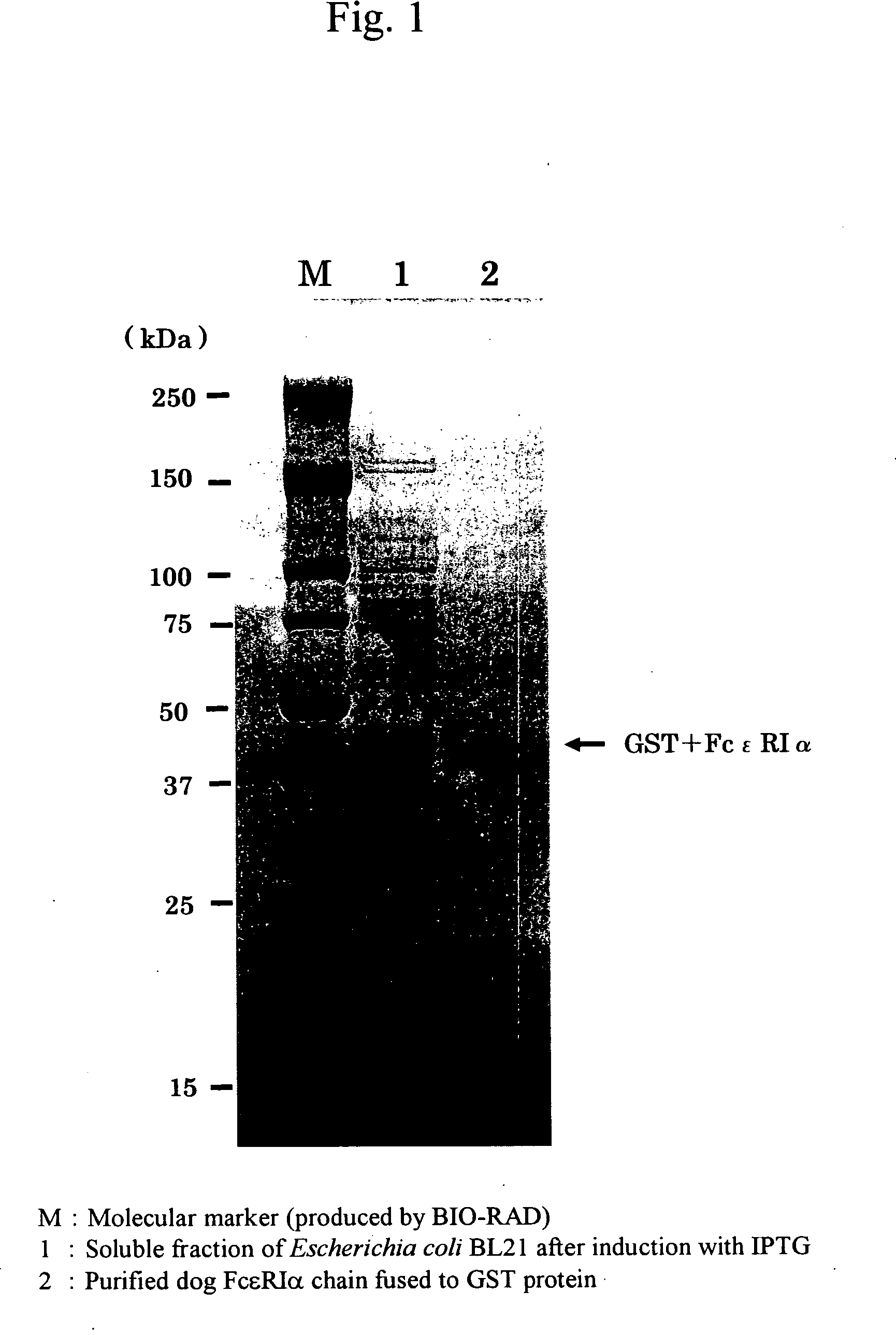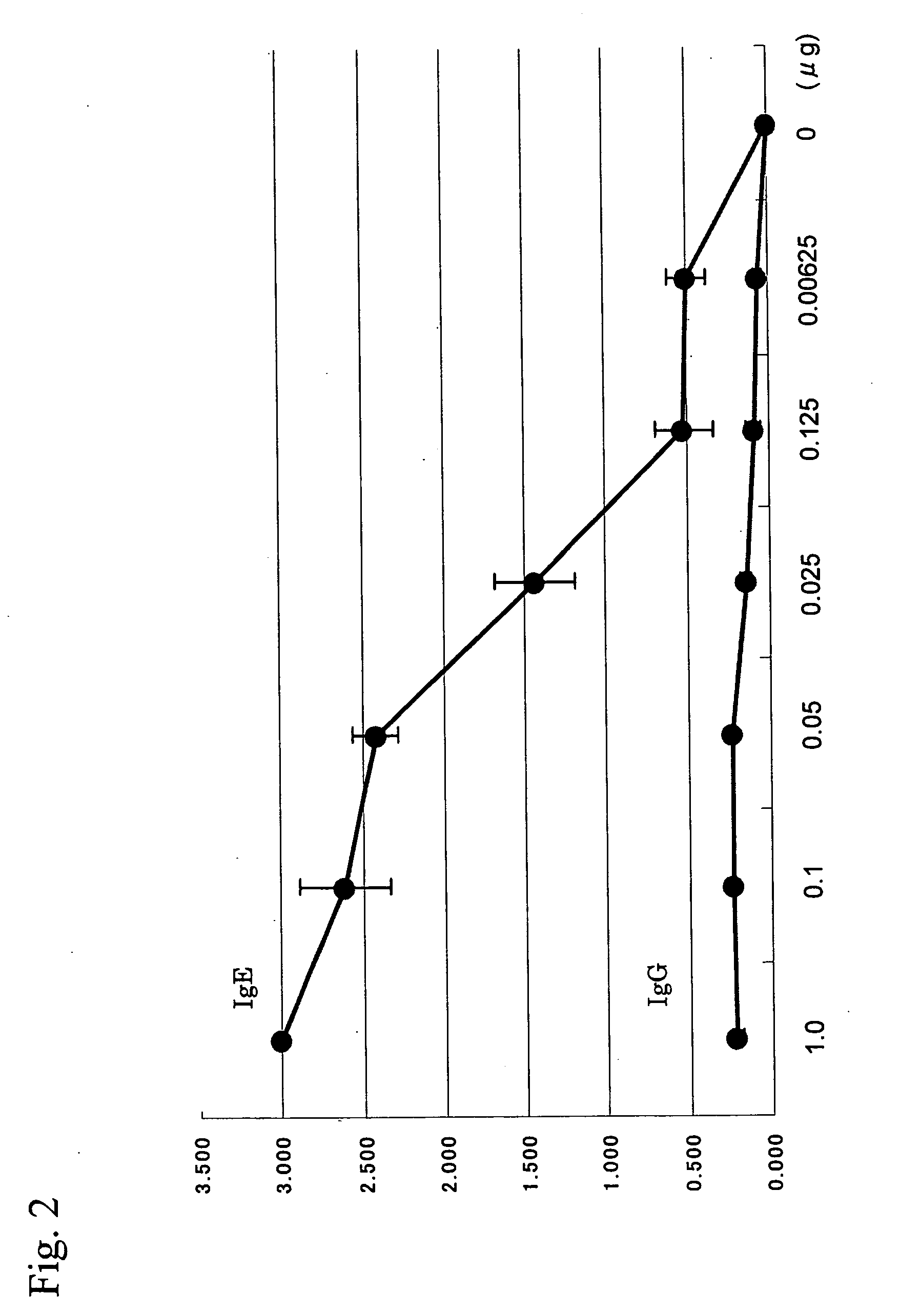Novel Mite Allergen
a technology of mite allergens and mites, which is applied in the direction of depsipeptides, peptide/protein ingredients, fungi, etc., can solve the problems of not being able to accurately diagnose mite allergic diseases, the composition of house dust has not been sufficiently studied, and the dose of house dust in such cases is extremely limited
- Summary
- Abstract
- Description
- Claims
- Application Information
AI Technical Summary
Benefits of technology
Problems solved by technology
Method used
Image
Examples
example 1
Establishment of an IgE Detection System
[0106]The extracellular region of a dog high-affinity IgE receptor α chain (FcεRIα) cDNA, excluding its signal peptide site and having had restriction enzyme EcoR I and Xho I sites added thereto, was amplified by PCR. The resultant was ligated to the EcoR I and Xho I sites of Escherichia coli expression plasmid vector pGEX4T-1 (produced by Amersham Biosciences) using T4-DNA ligase. An E.coli TOP10 strain (produced by Invitrogen) was transformed with the thus obtained recombinant plasmid. The transformed strain was cultured at 37° C. overnight in an LB medium containing ampicillin (100 μg / mL). Subsequently, a small amount of the strain was subcultured on a new LB medium until OD at 600 nm reached 1.0. Next, IPTG (isopropyl-1-thio-β-D-galactoside) was added to a final concentration of 1 mM. 3 hours later, cells were harvested and then washed once with PBS (pH 7.4). Cells harvested again were lysed by ultrasonication in PBS (pH 7.4), insoluble fr...
example 2
Analysis of a Major Mite Allergen by Western Blotting
[0107]Western blot analysis was conducted using the sera and blood plasma samples of eight dogs. The eight dogs had developed atopic dermatitis and had been diagnosed with mite allergies based on intracutaneous reactions using the solution of an antigen extracted from a Dermatophagoides farinae allergen (produced by GREER) and the ELISA method using the recombinant dog FcεRIα chain established in Example 1. β-mercaptoethanol was added to 100.0 μL of the solution of an antigen extracted from Dermatophagoides farinae to a final concentration of 50.0 μL / mL. 200 μL of the thus prepared Laemmli sample buffer (produced by BIO-RAD) was added, followed by heat treatment at 100° C. for 5 minutes. The resultant was applied to polyacrylamide gel (PAGEL; produced by ATTO) with a gel concentration between 5% and 20%, and then electrophoresis was performed. After completion of electrophoresis, the resultant was transferred to a PVDF membrane (H...
example 3
Analysis of a Mite Allergen Protein by 2-D (Two-Dimensional) Electrophoresis
[0108]An allergen protein with a molecular weight between 150 kDa and 250 kDa, with which IgE had strongly reacted, was isolated by 2-D (two-dimensional) electrophoresis. 2-D (two-dimensional) electrophoresis was performed using a Protean IEF cell (produced by BIO-RAD). 1.0 mg of an antigen extracted from Dermatophagoides farinae (produced by GREER) was dissolved in 1.0 mL of a swelling buffer (2-D starter kit; produced by BIO-RAD). 300 μL of the thus obtained solution was swollen under active conditions (50 V, 20° C., and 12 hours) using 17-cm-long IPG Ready strip gel (pH 4-7; produced by BIO-RAD) and a focusing tray. After swelling, focusing was performed under the following conditions. First, a procedure to remove excessive salts was performed in step 1 (250 V, 20 minutes, and 20° C.). In step 2, voltage was elevated from 250 V to 10,000 V for 6 hours. In step 3, focusing was performed with a voltage of 1...
PUM
 Login to View More
Login to View More Abstract
Description
Claims
Application Information
 Login to View More
Login to View More - R&D
- Intellectual Property
- Life Sciences
- Materials
- Tech Scout
- Unparalleled Data Quality
- Higher Quality Content
- 60% Fewer Hallucinations
Browse by: Latest US Patents, China's latest patents, Technical Efficacy Thesaurus, Application Domain, Technology Topic, Popular Technical Reports.
© 2025 PatSnap. All rights reserved.Legal|Privacy policy|Modern Slavery Act Transparency Statement|Sitemap|About US| Contact US: help@patsnap.com



